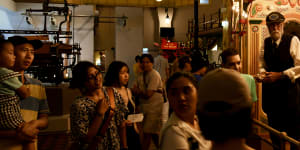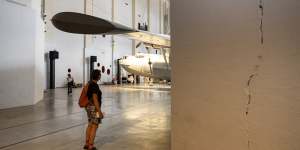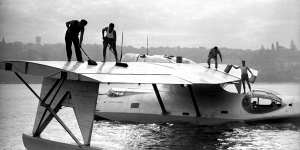Discussions are under way to display the seabird at the Historical Aviation Restoration Society’s museum in Albion Park as the museum closed its doors to the public at 5pm on Sunday for three years.

Sydneysiders flock to the Powerhouse on its final day before a three-year closure.Dean Sewell
Minutes before closing time critics of the closure gathered dozens of exiting visitors who,asked to declare their opinions,booed its closure. As the museum’s temporary closure was announced over the public address system,cries of “bullshit” and “liar” could be heard.
The Minns government is overseeing a $250 million renovation at Australia’s flagship science and technology museum,putting it at odds with the who say the government has yet to produce costings,or a safe plan for the removal of more than 3000 precious objects inside.
The museum’s closure before planning approvals,and public consultation,it said,was motivated by budget savings.
The Minns government maintains there have been no significant capital works to the heritage-listed Turbine Hall and Boiler House and its 1988 additions since the museum opened on Harris Street 36 years ago.
Arts Minister John Graham said the building had significant problems that needed to be urgently addressed,including leaks from the roof and large cracks in several walls. These leaks had resulted in mould and damp,and had put the collection at risk.

The project’s manager,Infrastructure NSW,said the costs would be materially greater if repairs and renovations were carried out in a staged manner while the museum remained open.
But former government architect Lionel Glendenning said one highlighted crack in the chimney in the Boiler House was not in fact a sign of deterioration but a single thermal expansion fracture preserved as part of the award-winning adaption of the Powerhouse building in 1988.
It had been kept as “evidence of the industrial life of all the buildings that was part of the Power House and Tram Depot complex”.

A thermal expansion fracture in the chimney was deliberately preserved.Louis Douvis
The flying Catalina is a prized exhibit of the Powerhouse’s transport exhibition,and with along with the Locomotive No. 1 and the Boulton&Watt steam engine will return to the museum when it reopens in 2027.
The Catalina Frigate Bird II was donated to the museum by the swashbuckling Australian aviator Captain P. J. Taylor who flew the plane across the South Pacific from Australia to Chile,via Tahiti and Easter Island in 1951 on a mission to find the shortest air route from Australia.
It’s been on display since the museum’s opening,the centrepiece of the museum’s transport exhibition.
A spokesperson confirmed the Powerhouse was in discussions about the feasibility of temporarily exhibiting the Catalina at HARS Aviation Museum subject to a conservation assessment of conditions and their appropriateness for the Catalina.
“The Catalina will not go anywhere that does not have the appropriate level of environmentally controlled conditioning to care for the object,” she said.
“The Catalina alongside other iconic objects from the museum’s collection will be reinstalled at Powerhouse Ultimo once revitalisation works are complete.”

Catalina flying boat Frigate Bird II at Rose Bay on the day of its flight to Chile in March 1951.Archive
Former museum senior transport curator Andrew Grant said the museum should not be entertaining the notion of disassembling and removing the Catalina at all.
“What is beyond doubt is that the proposed disassembly and removal of the Catalina and its relocation and reassembly places this highly significant aircraft at unnecessary risk,” he said
“It is also beyond doubt that the proposed storage-display conditions at HARS do not match the air-conditioned,climate controlled environment at Ultimo.
“I stress that this is not intended as a criticism of the HARS organisation or its members,who do a wonderful job preserving Australia’s aviation history.”
Other important objects including the Strasburg clock,the governor’s railway carriage and the air ambulance are destined for storage at Castle Hill.
Original components of The Kings’ Cinema,a recreated art deco cinema modelled on those built by the famous Kings Cinema chain in many of Sydney’s suburbs,will also be stored at Castle Hill.
Beyond the guaranteed return of the three famous objects,exhibition programming would determine what objects are exhibited when Powerhouse Ultimo reopens,a museum spokesperson said.
Start the day with a summary of the day’s most important and interesting stories,analysis and insights..